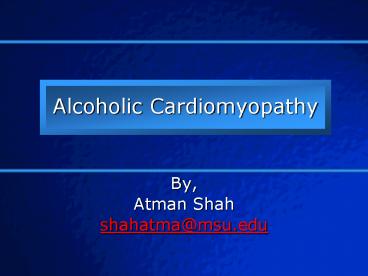Alcoholic Cardiomyopathy - PowerPoint PPT Presentation
1 / 19
Title:
Alcoholic Cardiomyopathy
Description:
1. Understanding alcohol metabolism in the human body ... Journal of Pharmacology and Experimental Therapeutics. Date: August 3, 1999 2001 By Default! ... – PowerPoint PPT presentation
Number of Views:631
Avg rating:3.0/5.0
Title: Alcoholic Cardiomyopathy
1
Alcoholic Cardiomyopathy
- By,
- Atman Shah
- shahatma_at_msu.edu
2
Introduction
- 1. Understanding alcohol metabolism in the human
body - 2. Research paper studying the effects of excess
metabolic byproducts on the heart
3
Alcohol Metabolism-1
- Ethanol is absorbed in the stomach and the
intestine and enters the blood. - In the liver and heart, an enzyme called alcohol
dehydrogenase (ADH) converts alcohol to
acetaldehyde. - Acetaldehyde is approximately 30 times more toxic
than alcohol, acetaldehyde is a major cause of
alcohol-associated side effects. (Drunkenness,
hangovers)
4
Alcohol Metabolism-2
- Acetaldehyde is rapidly converted to acetate by
other enzymes. - Acetate (acetic acid) is is eventually
metabolized to carbon dioxide and water.
5
Research Article
Published in Journal of Pharmacology and
Experimental Therapeutics Date August 3, 1999
6
Purpose of This Study
To show that acetaldehyde overproduction causes
Alcoholic Cardiomyopathy (ACM) The
acetaldehyde overproduction is artificially
produced by altering genes (transgenic) in mice.
7
Methods and Results
- Develop transgenic mice
- Analysis of transgene expression
- Chronic treatment of mice with ethanol
- Study the effects on the heart
8
Develop Transgenic Mice
- The genes responsible for transcribing Alcohol
Dehydrogenase (ADH) are altered to produce more
ADH - (Alcohol is converted into acetaldehyde by ADH)
- The MyADH transgene was produced by replacement
of the catalase coding sequence in the transgene
MyCAT with the coding sequence for rat ADH
9
Analysis of Transgene Expression
- FVB are normal (non-transgenic) mice
- Line 239 and 258 both show high enzyme activity
- Line 239 is selected for the study since it also
shows a better color coat, useful for
identification.
- Figure 1
- Shows expression of the transgene compared to
normal mice. - Level of expression is measured by enzyme
activity.
10
Analysis (Cont)
- Figure 2 Shows rRNA isolated from various
tissues probed with a fragment specific to the
transgene product. - Multiple Northern blots of different transgenic
tissue identified the expression of the MyADH
transgene ONLY in the heart.
11
Will These Mice Really Work in the Study?
- I.P. injection of 3g/kg alcohol
- Amount of acetaldehyde in the mice was detected
using gas chromatography.
Figure 3 Shows that transgenic mice have 4 times
more acetaldehyde than control mice.
12
Chronic Treatment of Mice With Ethanol
- The animals were initiated on a 1 alcohol (by
volume) liquid diet for 10 weeks. - The quantity of alcohol was gradually increased
to 4. - After 10 weeks the mice were sacrificed and their
hearts were studied.
13
Effects on the Heart
- Increased expression of
- Alpha-skeletal actin (SkActin) and
- Atrial Natriuretic factor (ANF)
- (Provide a sensitive indicator of cardiac damage
in cardiomyopathies)
14
Indicators of Cardiac Damage (1)
- Figure 4
- Shows that levels of mRNA of both SkActin and
ANF were significantly increased in alcohol
treated mice.
15
Indicators of Cardiac Damage (2)
- After 5-months on an alcohol diet mouse hearts
had enlarged. - There was a more dramatic cardiac enlargement in
transgenic mice. - Heart-to-Body ratio increased to 18 in control
mice and 80 in transgenic mice.
16
Indicators of Cardiac Damage (3)
- Electron microscopy revealed morphological
changes in the myocardium of alcohol-treated
mice. - Normal mice that were treated showed mild effects
such as sarcoplasmic edema. - Transgenic mice showed more global effects such
as - Loss of sarcoplasmic reticulum
- Degenerated and/or smaller mitochondria
- Disorganized cristae in mitochondria
17
Electron Microscopy
- A and C are not treated with alcohol (control)
- B and D are treated with alcohol
- C and D are taken from transgenic mice
18
Indicators of Cardiac Damage (4)
- A pressure transducer was used to measure
contractility.
- Figure 7
- 18-weeks of alcohol diet reduced the
contractility in both control and transgenic
mice.
19
Conclusion
Increased acetaldehyde exposure to the myocardium
produced alcoholic cardiomyopathy in mice.
- Future research
- Trying to produce transgenic mice that have
excess acetaldehye dehydrogenase, to protect the
heart from the damaging effects of acetaldehyde.































